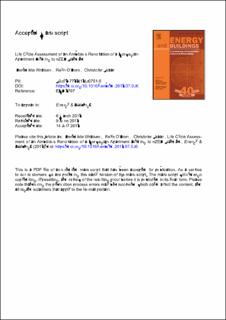| dc.contributor.author | Wrålsen, Benedikte | |
| dc.contributor.author | O'Born, Reyn Joseph | |
| dc.contributor.author | Skaar, Christofer | |
| dc.date.accessioned | 2019-05-10T10:07:48Z | |
| dc.date.available | 2019-05-10T10:07:48Z | |
| dc.date.created | 2018-07-14T19:47:29Z | |
| dc.date.issued | 2018 | |
| dc.identifier.citation | Wrålsen, B., O´Born, R. J. & Skaar, C. (2018). Life cycle assessment of an ambitious renovation of a Norwegian apartment building to nZEB standard. Energy and Buildings, 177, 197-206. doi: | nb_NO |
| dc.identifier.issn | 0378-7788 | |
| dc.identifier.uri | http://hdl.handle.net/11250/2597219 | |
| dc.description | Author's accepted manuscript. | |
| dc.description.abstract | The upgrading of building infrastructure to modern standards represents a key tool for reducing global energy demand and emissions from buildings. In Norway, building upgrades have been prioritized despite the relatively low carbon intensity of the Norwegian energy mix through various incentive programs and continual improvement in building standards. Prioritizing upgrades is important as up to 90% of the existing Norwegian building stock is expected to remain standing by the year 2050. The overall impact of upgrading buildings is expected to be a net benefit to the environment but this is primarily in operation, and many studies on energy do not include the materials and resources required for upgrading. The ambitious building upgrade in the Stjernehus apartment block in Kristiansand, Norway represented an opportunity to analyse the emissions and cumulative energy demand of renovation strategies in a real-world case study. The Stjernehus apartment block, once declared the coldest apartment block in Norway, was renovated from 1960s standards to nearly passive house standard, leading to considerable improvements in operational energy demand. The renovation was evaluated in this study with respect to energy demand and overall lifetime environmental emissions using life cycle analysis over a 30-year period, and with three different scenarios for the energy supply. The results of this study show that despite the low carbon intensity of the Norwegian energy mix, there was a considerable environmental benefit to renovation. It is recommended that renovation of existing buildings continue as part of a successful climate mitigation strategy in Norway. | nb_NO |
| dc.language.iso | eng | nb_NO |
| dc.publisher | Elsevier | |
| dc.rights | Attribution-NonCommercial-NoDerivatives 4.0 Internasjonal | * |
| dc.rights.uri | http://creativecommons.org/licenses/by-nc-nd/4.0/deed.no | * |
| dc.title | Life Cycle Assessment of an Ambitious Renovation of a Norwegian Apartment Building to nZEB Standard | nb_NO |
| dc.type | Journal article | nb_NO |
| dc.type | Peer reviewed | nb_NO |
| dc.description.version | acceptedVersion | nb_NO |
| dc.source.pagenumber | 197-206 | nb_NO |
| dc.source.volume | 177 | |
| dc.source.journal | Energy and Buildings | nb_NO |
| dc.identifier.doi | 10.1016/j.enbuild.2018.07.036 | |
| dc.identifier.cristin | 1597332 | |
| cristin.qualitycode | 2 | |

